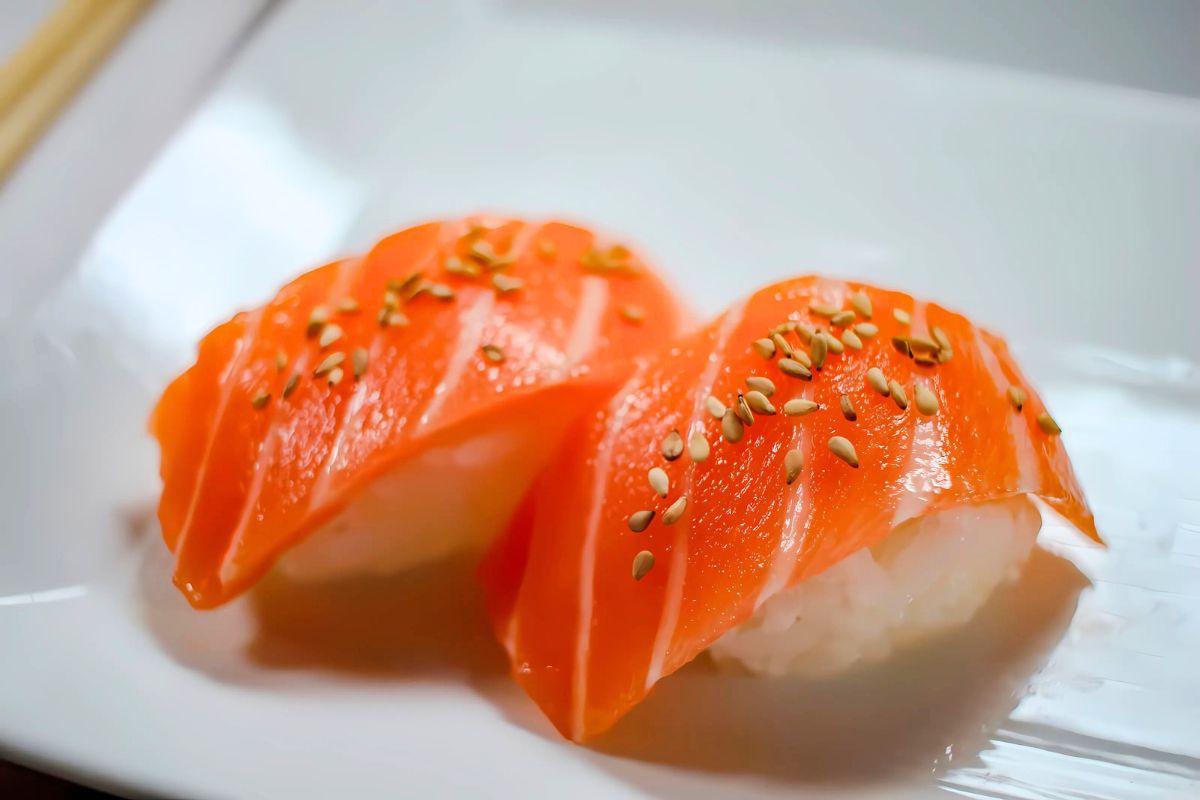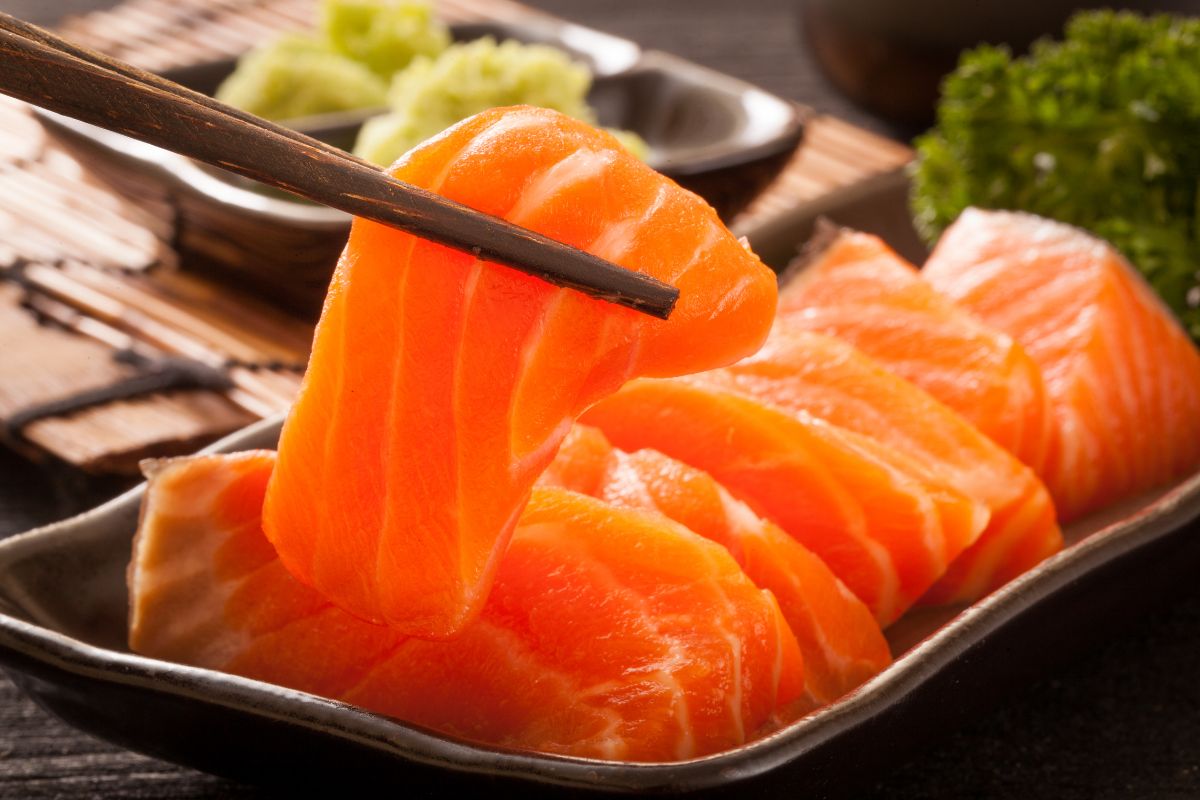Japanese cuisine has always been renowned for its subtle flavors, meticulous techniques, and the use of fresh and premium ingredients. Two of the most iconic dishes Japan has to offer, nigiri and sashimi, are often misunderstood outside of the country. While most Japanese restaurants offer sushi, very few tourists understand the concept fully and end up with sashimi or sushi. This is the nigiri vs sashimi debate. The difference between sashimi and nigiri goes beyond mere taste. This article aims to explain all about nigiri and sashimi so that readers can appreciate the art and culture more.
What is Nigiri?
When it comes to sushi, nigiri is classified as one of its types, traditionally consisting of a shaped mound of vinegared rice topped with a slice of fish or other seafood. “Nigiri” is derived from the Japanese term for “to grasp” or “to hold” and refers to how the cooks shape the rice by hand into a compact oval. The rice is placed in a compact mound, raw fish is gently placed over the rice, and sometimes a dash of wasabi is added for an extra kick.

Because of its simpler preparations, nigiri is considered one of the purer forms of sushi, as it accentuates the ratio of seasoned rice to raw fish. It is commonly served in pairs, which is meant to be consumed in one or two bites. Other common toppings may also include tuna, salmon, and shrimp, but other more exotic types like eel, squid, and even octopus are also sometimes used. Occasionally, a thin strip of seaweed is utilized to hold the topping in place.
What is Sashimi?
Sashimi is a delicate Japanese delicacy that consists of thinly sliced raw seafood or fish. Rice isn’t added here, as it is with sushi. Instead, sashimi emphasizes the fish itself and its freshness. It is often considered one of the most sophisticated forms of Japanese cuisine because preparing sashimi requires extremely skillful knife work and knowledge of the various seafood. Sashimi is fairly common in traditional Japanese meals and is often served as an appetizer. It is typically served with soy sauce for sashimi dipping, wasabi, pickled ginger, and shredded radish daikon. The most popular sashimi are tuna, salmon, mackerel, scallops, yellowtail, and more.

Nigiri vs Sashimi: The Key Differences
The nigiri vs sashimi debate differs primarily in the inclusion of rice. While the former includes rice (making it a subtype of sushi), the latter does not. This slight difference has profound effects in terms of the texture, taste, and even nutritional value of the dish. Nigiri sushi lightly presses slices of fish atop a ball of slightly tangy rice. The flavor of the raw fish is often mellowed a bit by the rice, making it more accessible to those new to sushi.
Sashimi, on the other hand, presents the fish in its unadulterated form. There are no other elements to distract—merely the taste, color, and feel of the seafood, which is often savored by seasoned or more daring diners. Sashimi is often served as a main course, while nigiri is part of a sushi set or platter. Both are exquisitely crafted and while nigiri is adorned beautifully, sashimi is often artistically sliced and arranged to showcase the skill of the chef.
Which is Healthier?
The debate about nigiri and sashimi becomes crucial when considering someone’s health, especially about calories, and becomes a comparing game of guidelines that is more nutritious and calorie-friendly. The absence of rice in sashimi makes it a preferable choice for dieters, as it is usually lower in calories and carbs. Sashimi also contains a high amount of protein and omega-3 fatty acids, making it suitable for people on ketogenic or low-carb diets.

Nigiri, while also healthy, includes vinegared rice, which adds some calories and carbs to the meal. However, the rice makes nigiri more filling, providing energy and satiety. It’s a balanced choice if you’re looking for a light yet satisfying meal.
The Art of Preparation
One of the most interesting parts of the debate between nigiri and sashimi is the prep work involved. Sashimi is one of the dishes with the most unique cutting techniques. The chef has to slice the fish at the perfect angle due to the fragile texture. The thickness and shape of each cut greatly affect the mouthfeel of the fish and how its flavor is released.
With nigiri, the challenge isn’t how to cut the fish but how to mold the rice and balance it with the topping. The rice has to be firm enough to hold its shape yet soft enough to practically dissolve in the mouth. The fish needs to rest gently atop the rice without burying it so that there is a blend of taste and texture.
When to Choose Nigiri or Sashimi
So, when should you choose nigiri over sashimi or vice versa? Choose nigiri if you’re looking for a more substantial dish. The rice provides body and makes it a more filling option. Nigiri is also ideal for those new to eating raw fish, as the rice helps balance the flavors and textures. Opt for sashimi if you’re after a lighter, cleaner-tasting experience. Sashimi is perfect for those who want to savor the natural flavor of the seafood without any distractions. It’s also a favorite among health-conscious diners and those on specialized diets. Of course, you don’t have to choose just one. A balanced meal might include both nigiri and sashimi to provide variety and contrast.
How To Prepare
Preparing sashimi and nigiri at home starts with sourcing the freshest, sushi-grade fish—typically salmon, tuna, or yellowtail. For sashimi, simply slice the chilled fish into thin, even pieces using a very sharp knife, and serve it with soy sauce, wasabi, and pickled ginger. For nigiri, shape small mounds of seasoned sushi rice with damp hands, then gently press a slice of raw fish on top. Optionally, add a tiny dab of wasabi between the rice and fish or wrap a thin strip of seaweed around it for added hold. Keep everything chilled until ready to serve.
Cultural Significance
In Japanese cuisine, nigiri and sashimi transcend mere culinary creations—they embody an intricate balance of ingredient appreciation, exemplary craftsmanship, and historical reverence. During formal meals, sashimi is served early on, acting as an ‘amuse-bouche’ for the palate and setting the stage for even more intricate culinary masterpieces. Later in the meal, to encapsulate the essence of nigiri, it is served as an amalgamation of fish atop rice which is much easier to gage as ‘filling.’
Also read: China Vows ‘Firm and Forceful’ Countermeasures as U.S. Tariffs Escalate
Final Thoughts
The nigiri vs sashimi debate isn’t about declaring a winner. Rather, there lies a myriad of perspectives that exist, focusing on the subtle differences and unique experiences present in each dish. Step aside from the intricate masterpieces; nigiri and sashimi both follow simplistic elegance. If you are fond of eating sushi or simply want to try out Japanese cuisine, knowing the difference between nigiri and sashimi will help you make more informed choices.
